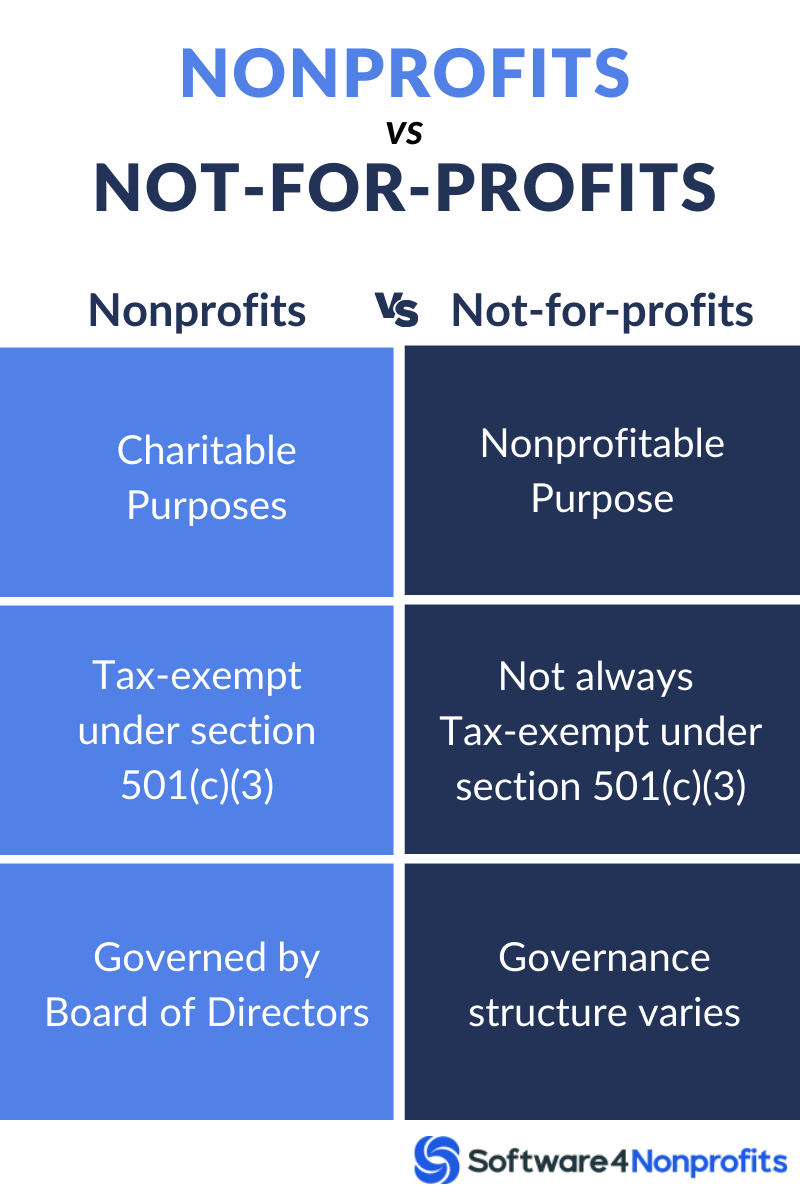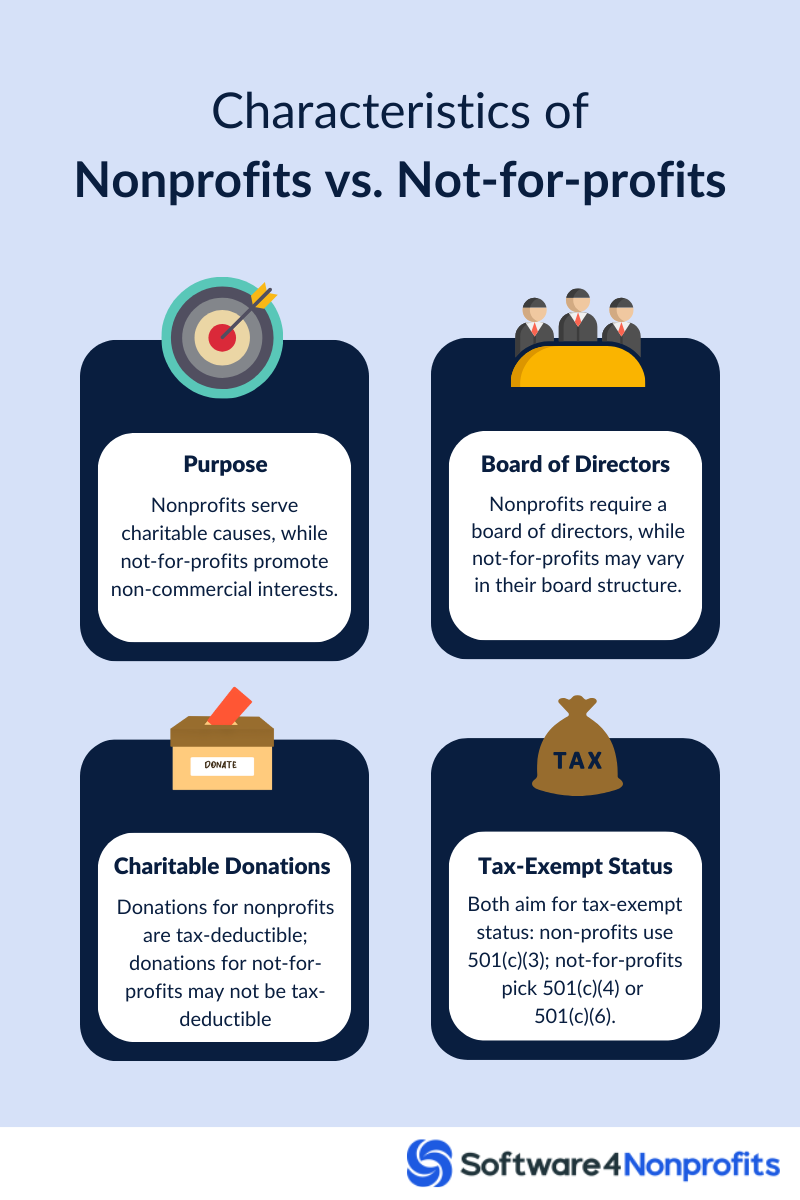When it comes to organizations that are not focused on generating profit, the terms non-profit and not-for-profit are often used interchangeably. While these two types of organizations share many similarities, there are also key differences that set them apart. We’ll take a closer look at non-profit vs not-for-profit organizations, including their tax-exempt status, board of directors, objectives, and more.
Non-profit Organizations
Non-profit organizations are established for charitable purposes, such as providing relief to the poor, advancing education, and promoting religion.
These organizations are tax-exempt under Section 501(c)(3) of the Internal Revenue Code. They can receive tax-deductible donations from individuals and corporate sponsors. Non-profit organizations must demonstrate that their activities primarily aim at advancing these charitable purposes to acquire tax-exempt status.
A board of directors generally governs non-profit organizations, and they are responsible for deciding on the organization’s activities and finances. Depending on the organization’s size and structure, the board of directors may compose of volunteers or paid members.
Not-for-Profit Organizations
Not-for-profit organizations, on the other hand, may be established for any purpose that is not focused on generating profit. These organizations may include social clubs, private foundations, and business leagues.
While not-for-profit organizations are not eligible for tax-exempt status under Section 501(c)(3), they may still be exempt from federal income tax if they meet certain requirements under Section 501(c)(4) or (c)(6).
The governance of not-for-profit organizations depends on the organization’s structure. Governing of these organizations may be through a board of directors or by a single individual. A committee of members can manage a social club, while a family or corporation can control a private foundation.
Differences Between Non-profit and Not-for-profit Organizations

Let’s take a closer look at the differences between non-profit and not-for-profit organizations. Understanding these differences can help individuals and organizations make informed decisions when it comes to creating or supporting a specific cause or group.
Purpose
An organization’s objectives are really important while classifying the organization.
The non-profit sector is established to serve the public interest or advance a specific charitable purpose. Their primary focus is on providing services or resources to those in need, rather than generating profits. Non-profit organizations may be involved in a wide range of activities, such as providing healthcare services, funding research, promoting social justice, or supporting the arts.
Not-for-profit organizations, on the other hand, may have any non-commercial purpose, such as promoting social welfare, amateur sports, or community development. These organizations promote a specific interest or cause that is not intended to generate profits, and their purpose is not necessarily charitable or focused on public benefit.
A board of directors is required for non-profit organizations. They manage the organization’s affairs, ensuring it operates according to its mission and the law. The board makes important decisions about the organization’s direction, hires and oversees staff, and ensures financial stability.
Not-for-profit organizations may or may not have a board of directors, depending on their structure and governance. For example, a social club may be organized as a not-for-profit organization but may not have a board of directors.
Charitable Donations
Charitable non-profits such as religious organizations or public charities are generally able to receive tax-deductible donations from individuals and corporate sponsors. This can be a significant source of funding for programs and operations of charitable organizations. Non-profit organizations often use these donations to support their charitable activities, such as funding medical research, public goods, or public safety.
Not-for-profit organizations may also receive donations, but they may not be tax-deductible for the donor. For example, a non-profit promoting amateur sports might get donations, but they may not be tax-deductible.
Tax-Exempt Status
Both not-for-profit and non-profit organizations may qualify for tax-exempt status, meaning they are not mandated to pay federal income tax on their earnings. However, the specific tax-exempt status will depend on the organization’s activities and purposes.
In the United States, the Internal Revenue Service (IRS) is responsible for overseeing tax-exempt organizations, including non-profit and not-for-profit organizations. The IRS has specific requirements that organizations must meet in order to obtain and maintain tax-exempt status.
A non-profit corporation is generally eligible for 501(c)(3) tax-exempt status, which allows it to receive tax-deductible donations and avoid paying federal income tax. To qualify for 501(c)(3) status, an organization must exclusively organize and operate for charitable, educational, scientific, religious, or literary purposes.
Many non-profit organizations covet this status, as it allows them to receive tax-deductible donations. This can be a significant source of funding for their programs and operations.
Not-for-profit corporations may be eligible for other types of tax-exempt statuses, such as 501(c)(4) status for social welfare organizations or 501(c)(6) status for business leagues. Their tax-exempt status depends on their formalities and activities.
These organizations may not be eligible to receive tax-deductible donations, but they may still be exempt from paying federal income tax on their earnings. Plus, a not-for-profit organization might have to pay property taxes.
Thanks, @CoffeewithCarl for this amazing video!
Sales Tax
A non-profit institution may be exempt from paying sales tax on purchases related to its charitable activities. However, they must look up the laws of the state they are operating in to ensure they obtain the required documents for sales tax exemption. For example, a non-profit organization that provides food to those in need may be exempt from paying sales tax on the food it purchases.
Not-for-profit organizations’ tax exemption for sales tax depends on state laws and their activities. For example, if a not-for-profit organization sells merchandise as part of its fundraising efforts, it may have to collect and remit sales tax.

Conclusion
In conclusion, non-profit and not-for-profit organizations are similar in many ways, but there are also some notable differences between them. Both types of organizations are established to serve a specific purpose and are prohibited from distributing profits to their owners or members. While not-for-profits can engage in various activities that benefit their members or community, non-profits have a different focus. Non-profits concentrate on promoting a specific social cause or charitable mission. Ultimately, both types of organizations play an important role in society. They contribute to making a positive impact on the world.



